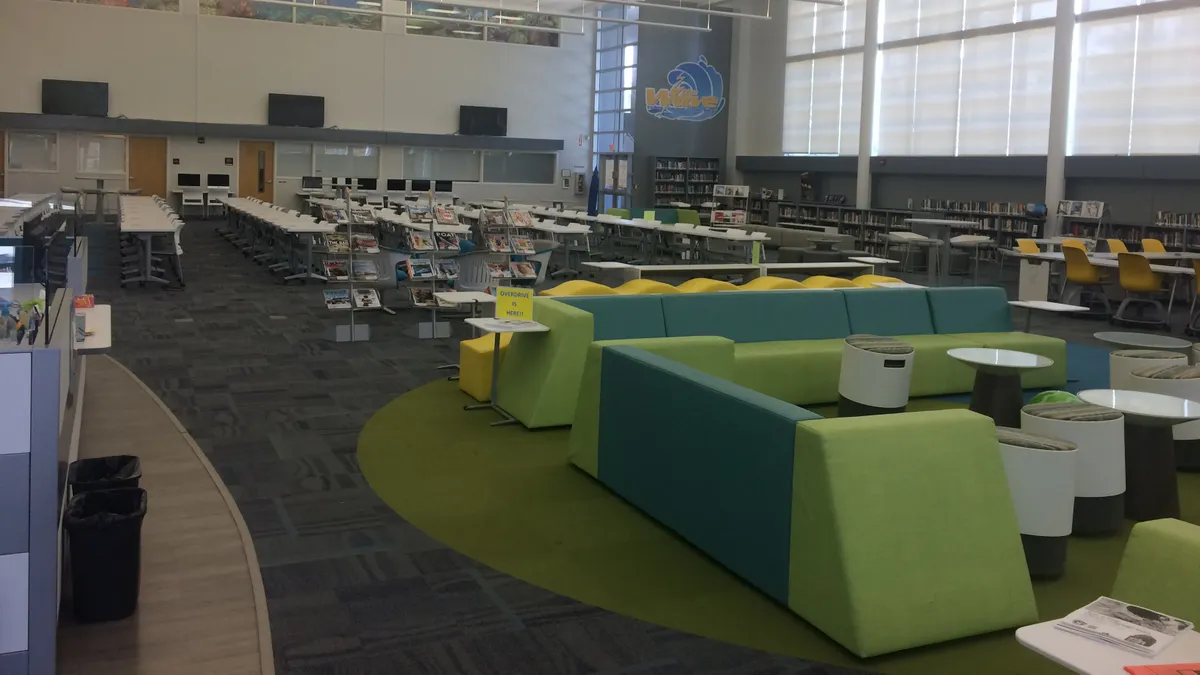Dive Brief:
- Shawn Maas, media specialist at Cypress Bay High School in Weston, Florida, detailed how his school revamped its media center for 21st century learning, access, equity and inclusion in a Tuesday afternoon session streamed during this year's virtual edition of the Future of Education Technology Conference.
- Particularly, Maas said the revamp allowed the school to make better use of a 6,000 square foot space while leveraging ebooks and audiobooks to boost reading engagement and support multilingual learners.
- In 2014, for example, library checkouts were about 400 and are now approaching 10,000 since the re-imagining of the media center — dubbed "The Wave" — launched in May 2015. In April 2020, during the first month of closures due to the COVID-19 pandemic, data showed 3,161 books were opened via the school's ebook platform, with over 1,600 hours of reading logged.
Dive Insight:
Cypress Bay High School is ranked as a gold-level best high school by U.S. News, with a 97.29 overall score. Maas concedes that the school being located in an affluent community gives it access to resources other schools may not have. But it’s also a diverse school, with a majority Hispanic (60%) student population. Additionally, 7% of students are Asian, with largely Chinese or Korean backgrounds, and 4% are African American.
The school opened in 2002 and was built for 3,200 students. Current enrollment is 4,785.
"Space is always an issue," Maas said, noting that senior classes are generally between 1,100 and 1,200 students — larger than any of the school’s large gathering areas can hold at one time. Officials have previously had to use nearby Marlins Park baseball stadium for graduations.
That need for space, alongside underwhelming engagement with the school's library collection, contributed to the need to reimagine the school’s media center. With much of its space occupied by books, and furniture that was outdated and underutilized, the school knew it could make better use of that resource.
In the process of transforming its media center into The Wave, Maas said, CBHS retained 5,000 print titles — all fiction, because that was the category most checked out by students — and converted another 10,000 titles to ebook format via OverDrive Education's Sora app. The same print titles still displayed are also readily available through Sora.
A remaining 24,000 books in the school's collection were relocated throughout the district.
Since The Wave’s launch in 2015, checkouts have dramatically increased and are approaching 10,000 this year, he said. The data doesn’t support the widespread notion that students don’t like ebooks or prefer print to them.
"That’s something I was really shocked at as a media specialist," Maas said, also noting the role of PSA videos in helping acclimate students to the new platform.
The transition to OverDrive (which sponsored Maas' FETC session) also allows the school to maintain a 24-hour media center. At CypressBayMedia.com, students have the ability to access the school’s collection and information anytime, anywhere.
This was particularly crucial when COVID-19 hit, Maas said, suggesting if it wasn’t for the digital transition, he wouldn’t have known how to get reading materials to students during closures.
He also credits the move with helping the school boost access, equity and inclusiveness. Sora, for example, has a library of titles that is up-to-date and available in English and Spanish. It also has titles in Chinese, allowing the school to create an online Chinese language library. (AP Chinese is among the school's foreign language offerings.)
For reading and ESL classes, the platform features in-text definitions, Google Translate and customized readability options, in addition to OpenDyslexic font for students who have dyslexia.
The Wave also spotlights titles by diverse authors. And for students who struggle with print books, it has a selection of graphic novels and comics that help bridge divides for reluctant readers.
Likewise, read-along options at varying levels are available for the school's students-with-disabilities cluster, featuring a selection of visual and audio components.
Since making the change, Maas said 75.5% of English learners saw reading gains in 2017-18, and 77.6% saw gains in 2018-19. Scores overall also jumped 3% since The Wave launched, he said.
Beyond the adoption of the ebook platform, the media specialist said the school sought to provide a community space for students. The Wave offers small breakout meeting areas, a larger lecture-style seating area and a reading area, with all physical books pushed out to the walls. To ensure inclusivity, collaboration stations and other areas were furnished with wheelchair accessibility in mind.












